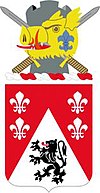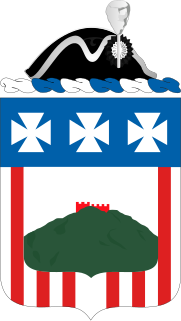
The 3rd United States Infantry Regiment is a regiment of the United States Army. It currently has three active battalions, and is readily identified by its nickname, The Old Guard, as well as Escort to the President. The regimental motto is Noli Me Tangere. The regiment is a major unit of the Military District of Washington (MDW).
The 9th Engineer Battalion is a unit of the United States Army that deploys to designated contingency areas and conducts combat and/or stability operations in support of a brigade combat team. It is a divisional mechanized combat engineer unit, composed of three line companies and a headquarters company. Its mission is to provide assured mobility, counter-mobility, general engineering, and survivability support, with well trained sappers ready to deploy anywhere at any time. The unit's history spans service in 1917 in the US southwest, World War II in France and Germany, multiple deployments to the Balkans, and multiple deployments in support of the Global War on Terrorism in Iraq and Afghanistan. It is most famous for the capture of the Ludendorff Bridge across the Rhine River. As of 18 May 2015, the battalion exists as the 9th Brigade Engineer Battalion in Fort Stewart, GA under 2nd Armored Brigade Combat Team, 3rd Infantry Division.

The 14th Infantry Regiment is a United States Army light infantry regiment. It has served in the American Civil War, Boxer Rebellion, World War II, Korean War, Vietnam War, Operation Restore Hope, Operation Uphold Democracy, Operation Joint Guard, Operation Desert Storm, Operation Enduring Freedom, Operation Gothic Serpent, Operation New Dawn, Operation Resolute Support, and Operation Iraqi Freedom. The 14th Infantry Regiment did not take part in combat during World War I. It has also conducted peacekeeping and humanitarian missions in the Sinai Peninsula, Guantánamo Bay in Cuba, Bosnia, and Kosovo.

The 199th Infantry Brigade (Light) is a unit of the United States Army which served in the Army Reserve from 1921 to 1940, in the active army from 1966 to 1970, briefly in 1991–1992 at Fort Lewis, and from 2007 as an active army training formation at Fort Benning.

The 27th Engineer Battalion (COMBAT)(AIRBORNE) and its subordinate companies have often used the Fort Bragg/XVIII Airborne Corps standard of "Airborne!" for its motto.

The 87th Infantry Regiment is an infantry regiment in the United States Army. The regiment's 1st and 2nd Battalions are light infantry units assigned to the 1st and 2nd Brigade Combat Teams respectively of the 10th Mountain Division located at Fort Drum, New York. The 3d Battalion was active in the U.S. Army Reserve in Colorado. The 4th Battalion was a Regular Army unit assigned to the 3rd Brigade Combat Team of the 25th Infantry Division (Light) at Schofield Barracks, Hawaii.

The 205th Infantry Brigade, was first formed as part of the United States Army Reserve's 103rd Division. It was active from 1921 to 1942 and then from 1963 through 1994, and then reformed in 2006.
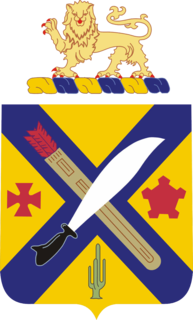
The 2nd Infantry Regiment is an infantry regiment in the United States Army that has served for more than two hundred years. It was constituted on 12 April 1808 as the 6th Infantry and consolidated with 4 other regiments in 1815 to form the present unit.

The 555th Engineer Brigade "Triple Nickel" is a combat engineer brigade of the United States Army based at Joint Base Lewis-McChord, Washington. The brigade is a Corps separate falling directly under I Corps. The 555 numbering was first used in 1947, but the brigade traces its history to a group active under the 1103d designation from 1943 to 1946.

The 52nd Infantry Regiment is an infantry regiment of the United States Army.
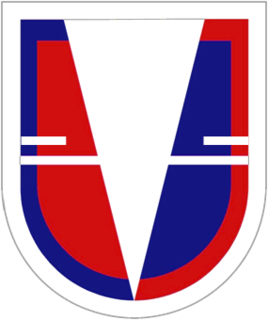
The 37th Engineer Battalion is an airborne engineer battalion in the United States Army, and currently subordinate to the 2d Brigade Combat Team, 82d Airborne Division, based at Fort Bragg, North Carolina. The 37th Engineer Battalion was reactivated in the 82d Airborne Division as part of the United States Army new BCT 2020 concept in which each BCT's Special Troops Battalions would be inactivated and reactivated as Brigade Engineer Battalions. Prior to this, the battalion was a subordinate unit of the 20th Engineer Brigade assigned to XVIII Airborne Corps.

The 412th Theater Engineer Command is a United States Army Reserve unit that conducts theater-level engineer operations for Eighth U.S. Army, Korea; U.S. Army Europe; and U.S. Army Pacific, supports continental U.S. – based engineer requirements as directed, and is prepared to participate in Joint and Combined regional contingency operations.

Known during World War II as the 31st Engineer Combat Battalion

The 864th Engineer Battalion is a combat engineer battalion of the United States Army based at Joint Base Lewis-McChord, Washington. The battalion is a subordinate unit of 555th Engineer Brigade.
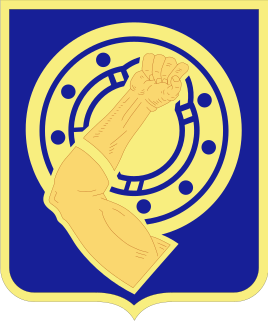
The 34th Armor Regiment is an armored regiment of the United States Army formed in 1941.
The 67th Armored Regiment is an armored regiment in the United States Army. The regiment was first formed in 1929 in the Regular Army as the 2nd Tank Regiment (Heavy) and redesignated as the 67th Infantry Regiment in 1932. It first became the 67th Armor in 1940. The regiment participated in World War I, World War II, Desert Storm/Desert Shield, Operation Iraqi Freedom, Operation Enduring Freedom, Operation Spartan Shield, Operation Inherent Resolve, Operation Resolute Support, and Operation Freedom's Sentinel.

The 14th Brigade Engineer Battalion is a Combat Engineer Battalion of the United States Army based at Joint Base Lewis-McChord, Washington. The battalion is a subordinate unit of the 2nd Stryker Brigade, 2nd Infantry Division, and I Corps. The battalion's official motto is "Gong Mu Ro" and battle cry "Rugged!".

The 6th Field Artillery Regiment is a Field Artillery Branch regiment of the United States Army first activated in 1907 from numbered companies of artillery. It was first organized with two battalions.
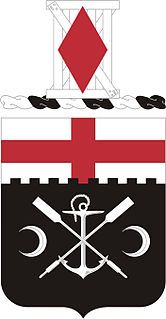
The 7th Engineer Battalion is a unit of the United States Army located at Fort Drum, New York. This battalion falls under the 10th Mountain Division's 1st Brigade Combat Team. The battalion has the Brigade Combat Team's engineer companies, military intelligence company, and signal company.
The 91st Engineer Battalion was a military engineer unit in the United States Army. The battalion, which was composed mainly of African-American troops, served in the Pacific Theater of Operations during World War II, when it was known as the 91st Engineer General Service Regiment. After the war, the unit was deactivated as part of the demobilization process. It was reactivated in 1952 and remained in existence until the early 1970s. In 1991 it was reactivated, after which it was employed on operations in Yugoslavia, Kuwait, Chad and Iraq before being deactivated again in 2005. On 16 October 2013, it was assigned to the 1st Brigade Combat Team, 1st Cavalry Division, and activated at Fort Hood, Texas.
